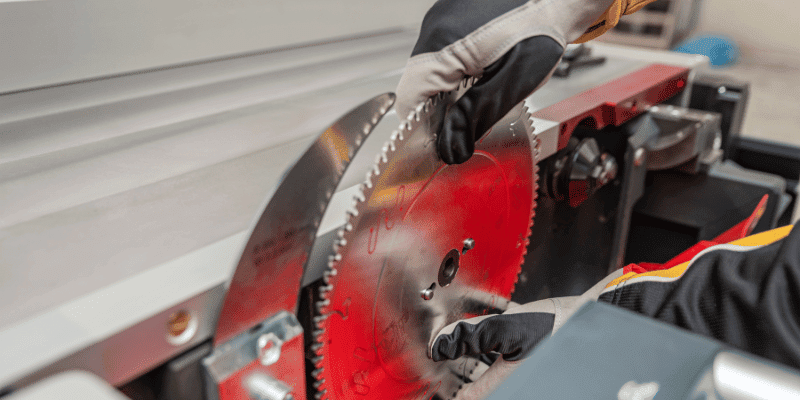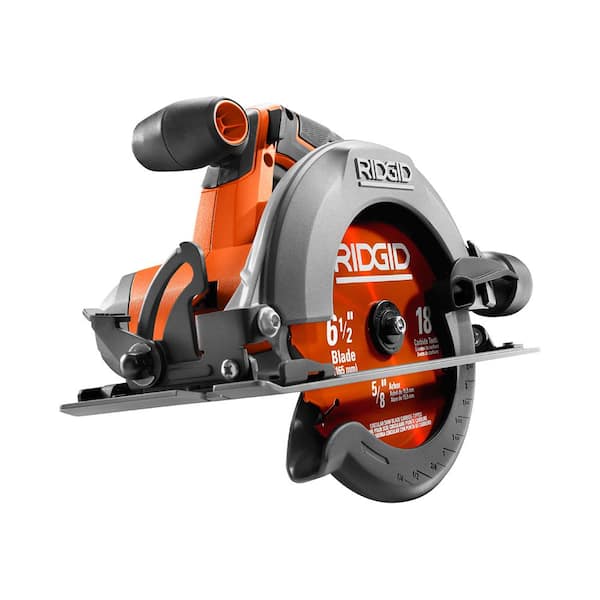To replace a circular saw blade, follow these steps: Disconnect the saw from the power source, remove the blade guard, loosen the arbor nut, remove the old blade, place the new blade on the arbor, tighten the arbor nut, and reattach the blade guard. Replacing a circular saw blade is a simple yet crucial task that ensures the efficiency and effectiveness of your saw.
By regularly replacing the blade, you can maintain optimal cutting performance and extend the lifespan of your tool. In this guide, we will walk you through the step-by-step process of safely and easily replacing a circular saw blade. By following these instructions, you can quickly swap out your old blade for a sharper and more effective one, enabling you to tackle your woodworking projects with confidence.
So let’s get started and learn how to replace a circular saw blade.
Why Replace A Circular Saw Blade
Replacing a circular saw blade is essential to ensure the optimal performance and safety of your saw. Over time, saw blades can become dull and inefficient, leading to less precise cuts and potential accidents. Regularly replacing the blade can help maintain the saw’s cutting power and efficiency.
Replacing the saw blade periodically is important because it helps to maintain the quality of the cuts and prevents the blade from becoming dull. A dull blade can cause the saw to overheat, leading to a decrease in cutting performance and potentially damaging the material being cut. By replacing the blade, you can ensure smooth and precise cuts, reducing the need for rework and saving both time and effort.
Using a sharp and efficient saw blade offers numerous benefits. It allows you to cut through materials faster and with less effort, resulting in increased productivity. Additionally, a sharp blade produces cleaner cuts, minimizing splintering and creating smoother edges. This is particularly important when working on projects that require precision, such as woodworking or carpentry. Moreover, a sharp blade minimizes the risk of kickbacks, which can occur when the blade gets stuck in the material and forcefully throws it back towards the operator.
In summary, replacing a circular saw blade periodically is crucial for maintaining cutting efficiency, ensuring safety, and achieving excellent results. By using a sharp and efficient blade, you can improve cutting speed, precision, and overall productivity.
Signs Your Circular Saw Blade Needs Replacement
Is your circular saw blade not performing as well as it used to? There are a few signs that indicate it may be time to replace your blade. The first sign is decreased cutting performance. If you notice that your saw is struggling to cut through materials or is leaving a rough finish, it may be a sign that the blade is dull or worn out.
Another sign to look out for is visible damage on the blade. Check for any missing or chipped teeth, cracks, or warping. These can all affect the blade’s ability to cut effectively and safely. Lastly, frequent kickbacks or binding can also indicate that it’s time for a new blade. If you’re experiencing the saw getting stuck or vibrating excessively during use, it’s a red flag.
Keeping an eye out for these signs can help you avoid accidents and ensure that your projects are completed smoothly. Remember to always follow the manufacturer’s guidelines when replacing your circular saw blade to ensure proper fit and safety. By replacing your blade when needed, you can continue to achieve clean, precise cuts.

Preparing For Blade Replacement
Replacing a circular saw blade is an important maintenance task that ensures the saw’s performance and safety. Before starting the replacement process, it’s essential to gather the necessary tools and equipment. These typically include a wrench or socket, to remove the blade’s retaining bolt, as well as a blade-change tool or piece of scrap wood to immobilize the blade. Additionally, ensuring safety precautions are in place is crucial. Make sure the saw is unplugged, to avoid any accidental starts. Wear protective gloves and safety glasses to shield yourself from any potential injuries. It’s also important to refer to the manufacturer’s instructions and recommended guidelines for specific safety measures and tool requirements for your circular saw model. By following these steps, you’ll be well-prepared to safely replace the circular saw blade.
Step-by-step Guide To Replacing A Circular Saw Blade
Replacing a circular saw blade is a straightforward process that can be done without professional help. To ensure safety during the replacement, it’s important to remove the old blade correctly. Begin by disconnecting the saw from the power source and carefully lowering the blade guard. Next, use a wrench to loosen the arbor nut and remove the old blade from the saw.
Once the old blade is removed, selecting the appropriate replacement blade is crucial. Consider the material you’ll be cutting and choose a blade with the appropriate tooth count and type. Install the new blade by aligning the mounting hole with the arbor and tightening the arbor nut securely using the wrench.
After installing the new blade, it’s essential to ensure proper tension and alignment. Use an appropriate tool to measure and adjust the blade tension according to the manufacturer’s instructions. Check the blade alignment and make any necessary adjustments to ensure it is centered and parallel to the saw table. Once everything is properly aligned, reattach the blade guard and test the saw to ensure smooth operation.
Tips For Maintaining And Extending The Life Of Your Circular Saw Blade
Tips for maintaining and extending the life of your circular saw blade:
- Regular cleaning of the blade: It is essential to clean the saw blade regularly to remove any debris or sawdust that may accumulate during use. This can be done using a brush or a mild detergent and water.
- Proper storage and handling techniques: When not in use, it is important to store the circular saw blade in a clean and dry place, preferably in a protective case or sheath. Avoid placing the blade on hard surfaces or exposing it to excessive moisture or high temperatures.
- Avoiding misuse and excessive pressure: To extend the life of your circular saw blade, ensure you are using the appropriate blade for the material being cut. Avoid forcing the blade or applying excessive pressure, as this can lead to overheating and damage.

Credit: www.homedepot.com
Frequently Asked Questions On How To Replace Circular Saw Blade
Are Circular Saw Blades Reverse Threaded?
No, circular saw blades are not reverse threaded. They are typically designed with regular right-hand thread rotation for cutting efficiency.
What Size Wrench Do I Need To Change A Circular Saw Blade?
To change a circular saw blade, you’ll need a wrench of the appropriate size. The exact wrench size will depend on the specific model of your circular saw. Check the saw’s manual or look for markings on the blade to determine the correct size wrench to use.
How Do I Know When My Circular Saw Blade Needs Replacing?
Replace your circular saw blade when you notice it’s dull or damaged. Signs include struggling to cut through materials, splintered edges, or burning marks. Regularly inspect the blade for wear and tear and replace it promptly to maintain optimal performance and safety.
How Do You Replace A Circular Saw Blade?
Replacing a circular saw blade involves loosening the arbor nut, removing the old blade, inserting the new blade, and tightening the arbor nut securely. Always follow the manufacturer’s instructions and use the appropriate safety precautions when replacing the blade on a circular saw.
Conclusion
To sum up, replacing a circular saw blade is a simple yet essential maintenance task for any DIY enthusiast or professional woodworker. By following the step-by-step guide provided in this blog post, you can easily extend the lifespan of your circular saw and ensure precise and efficient cuts every time.
Remember to prioritize safety and follow the manufacturer’s instructions for optimal results. With these tips in mind, you’ll be well-equipped to handle your circular saw blade replacements with ease. Happy woodworking!


